HYUNDAI TUCSON 2013 User Guide
Manufacturer: HYUNDAI, Model Year: 2013, Model line: TUCSON, Model: HYUNDAI TUCSON 2013Pages: 397, PDF Size: 5.55 MB
Page 11 of 397
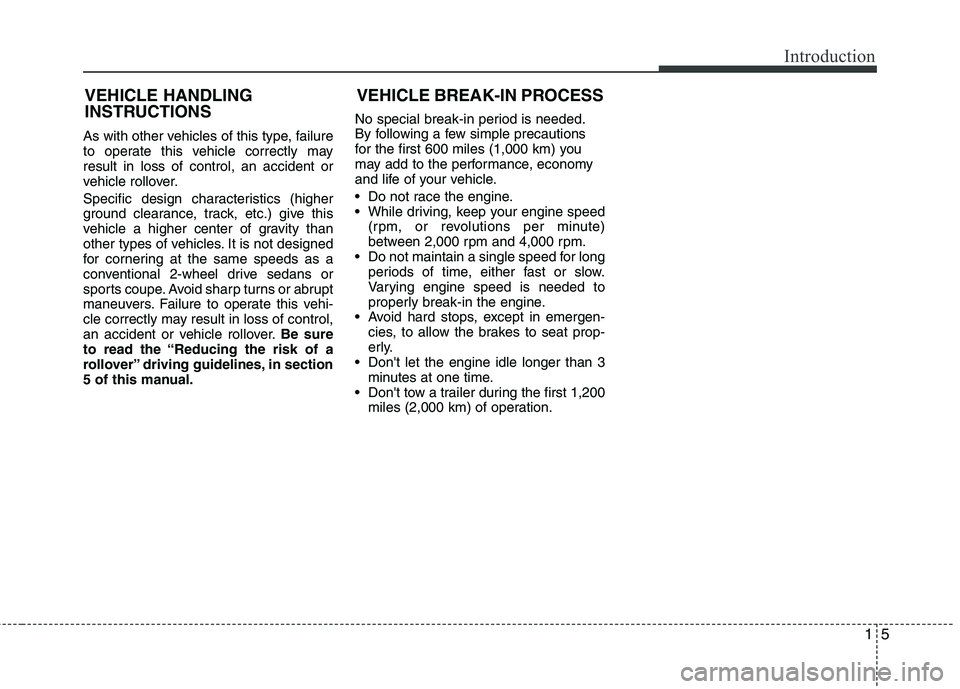
15
Introduction
As with other vehicles of this type, failure
to operate this vehicle correctly mayresult in loss of control, an accident or
vehicle rollover.
Specific design characteristics (higher
ground clearance, track, etc.) give this
vehicle a higher center of gravity than
other types of vehicles. It is not designed
for cornering at the same speeds as a
conventional 2-wheel drive sedans or
sports coupe. Avoid sharp turns or abrupt
maneuvers. Failure to operate this vehi-
cle correctly may result in loss of control,
an accident or vehicle rollover.Be sure
to read the “Reducing the risk of a
rollover” driving guidelines, in section
5 of this manual. No special break-in period is needed.
By following a few simple precautions
for the first 600 miles (1,000 km) you
may add to the performance, economy
and life of your vehicle.
Do not race the engine.
While driving, keep your engine speed
(rpm, or revolutions per minute)
between 2,000 rpm and 4,000 rpm.
Do not maintain a single speed for long periods of time, either fast or slow.
Varying engine speed is needed to
properly break-in the engine.
Avoid hard stops, except in emergen- cies, to allow the brakes to seat prop-
erly.
Don't let the engine idle longer than 3 minutes at one time.
Don't tow a trailer during the first 1,200
miles (2,000 km) of operation.
VEHICLE BREAK-IN PROCESS
VEHICLE HANDLING
INSTRUCTIONS
Page 12 of 397
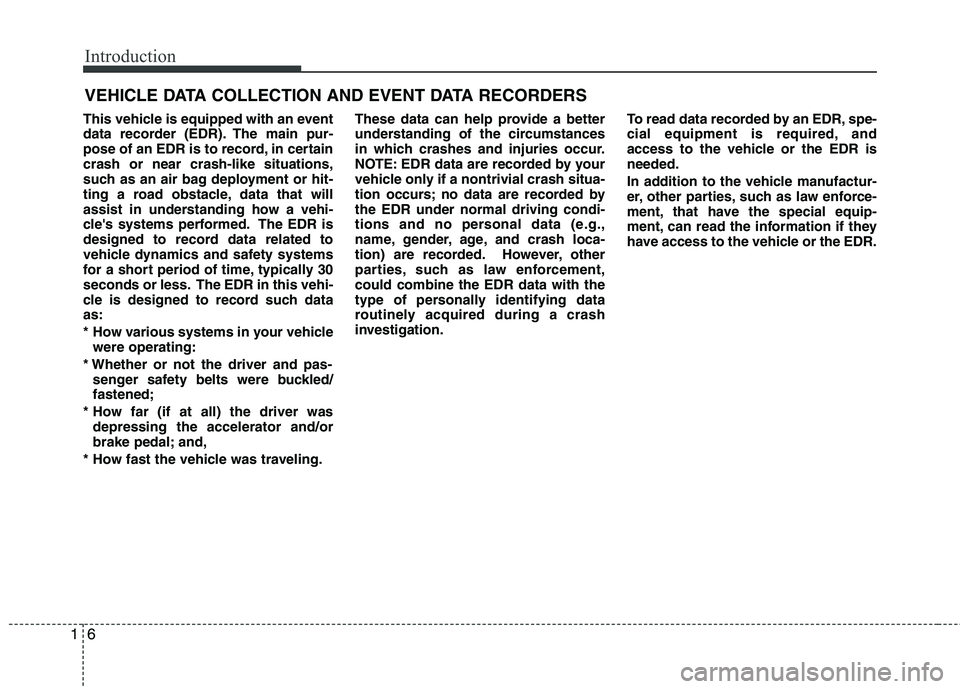
Introduction
6
1
This vehicle is equipped with an event
data recorder (EDR). The main pur-
pose of an EDR is to record, in certaincrash or near crash-like situations,
such as an air bag deployment or hit-
ting a road obstacle, data that will
assist in understanding how a vehi-
cle's systems performed. The EDR is
designed to record data related to
vehicle dynamics and safety systems
for a short period of time, typically 30
seconds or less. The EDR in this vehi-
cle is designed to record such data as:
* How various systems in your vehicle
were operating:
* Whether or not the driver and pas- senger safety belts were buckled/ fastened;
* How far (if at all) the driver was depressing the accelerator and/or
brake pedal; and,
* How fast the vehicle was traveling. These data can help provide a better
understanding of the circumstances
in which crashes and injuries occur.
NOTE: EDR data are recorded by your
vehicle only if a nontrivial crash situa-
tion occurs; no data are recorded by the EDR under normal driving condi-
tions and no personal data (e.g.,
name, gender, age, and crash loca-
tion) are recorded. However, other
parties, such as law enforcement, could combine the EDR data with the
type of personally identifying data
routinely acquired during a crash
investigation.
To read data recorded by an EDR, spe-
cial equipment is required, and
access to the vehicle or the EDR is needed.
In addition to the vehicle manufactur-
er, other parties, such as law enforce-
ment, that have the special equip-
ment, can read the information if they
have access to the vehicle or the EDR.
VEHICLE DATA COLLECTION AND EVENT DATA RECORDERS
Page 13 of 397
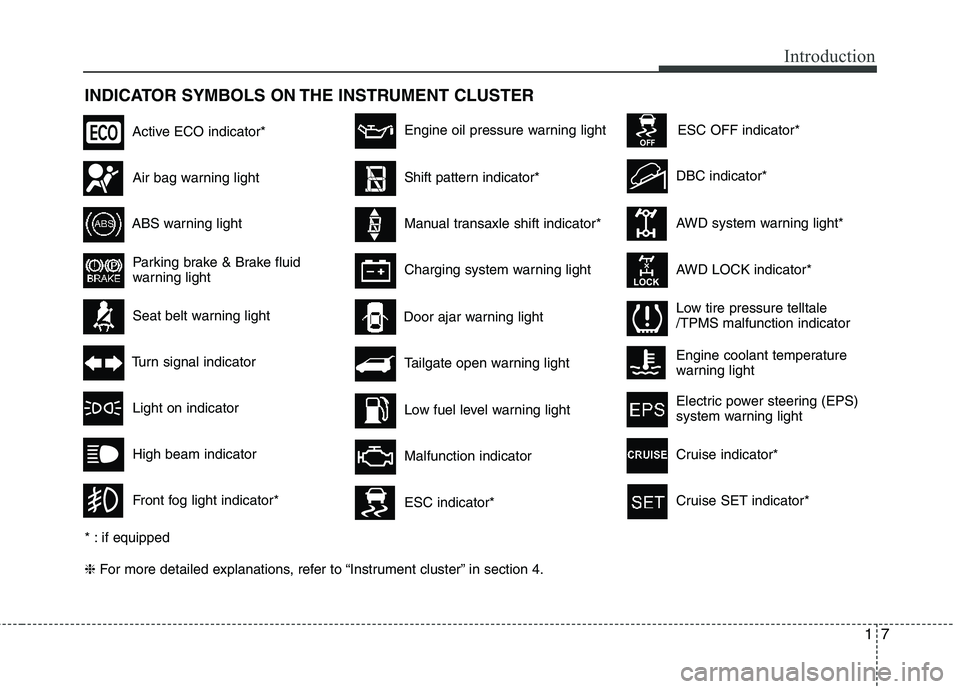
17
Introduction
INDICATOR SYMBOLS ON THE INSTRUMENT CLUSTER ❈For more detailed explanations, refer to “Instrument cluster” in section 4.
Seat belt warning light
Tailgate open warning light
High beam indicator
Light on indicator
Turn signal indicator
Front fog light indicator*
ABS warning light
Parking brake & Brake fluid
warning light
Engine oil pressure warning light
AWD system warning light*
AWD LOCK indicator*
Malfunction indicator
Air bag warning light
Low fuel level warning light DBC indicator*
Charging system warning light
Door ajar warning light
* : if equipped
ESC indicator*
ESC OFF indicator*
Low tire pressure telltale /TPMS malfunction indicator
Active ECO indicator*
Shift pattern indicator*
Manual transaxle shift indicator*
Engine coolant temperature
warning light
Electric power steering (EPS)
system warning light
Cruise indicator*
Cruise SET indicator*
Page 14 of 397
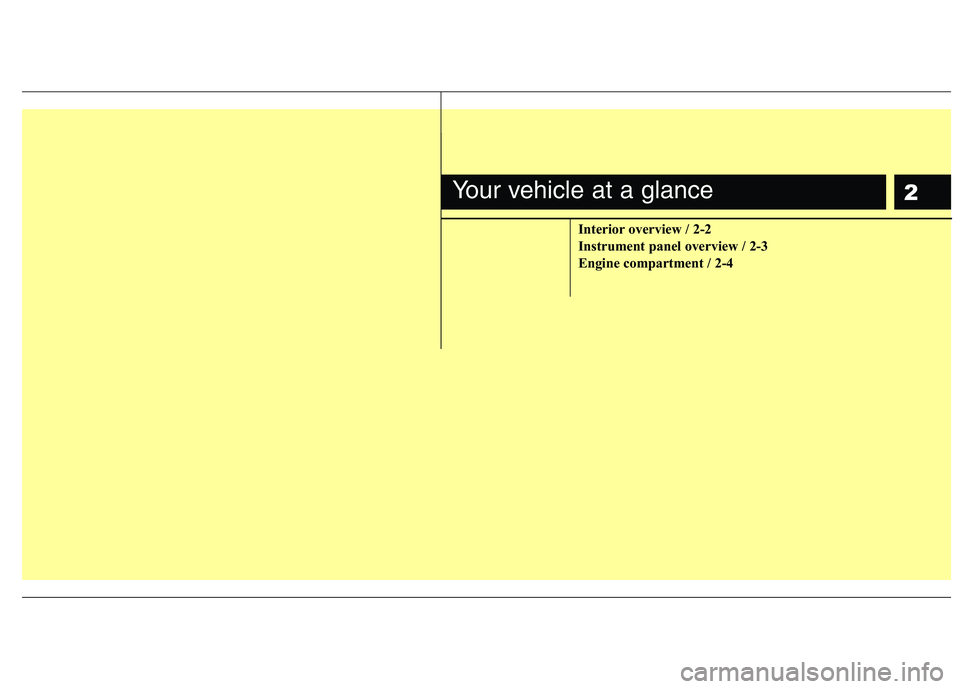
2
Interior overview / 2-2
Instrument panel overview / 2-3
Engine compartment / 2-4
Your vehicle at a glance
Page 15 of 397
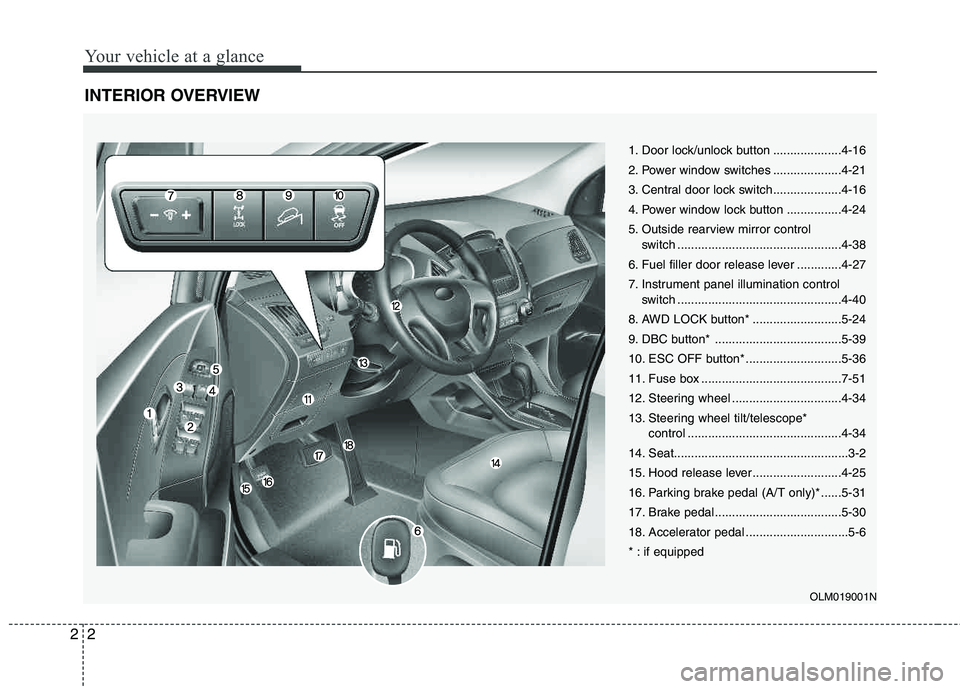
Your vehicle at a glance
2
2
INTERIOR OVERVIEW
1. Door lock/unlock button ....................4-16
2. Power window switches ....................4-21
3. Central door lock switch....................4-16
4. Power window lock button ................4-24
5. Outside rearview mirror control
switch ................................................4-38
6. Fuel filler door release lever .............4-27
7. Instrument panel illumination control switch ................................................4-40
8. AWD LOCK button* ..........................5-24
9. DBC button* .....................................5-39
10. ESC OFF button* ............................5-36
11. Fuse box .........................................7-51
12. Steering wheel ................................4-34
13. Steering wheel tilt/telescope* control .............................................4-34
14. Seat...................................................3-2
15. Hood release lever ..........................4-25
16. Parking brake pedal (A/T only)* ......5-31
17. Brake pedal .....................................5-30
18. Accelerator pedal ..............................5-6
* : if equipped
OLM019001N
Page 16 of 397
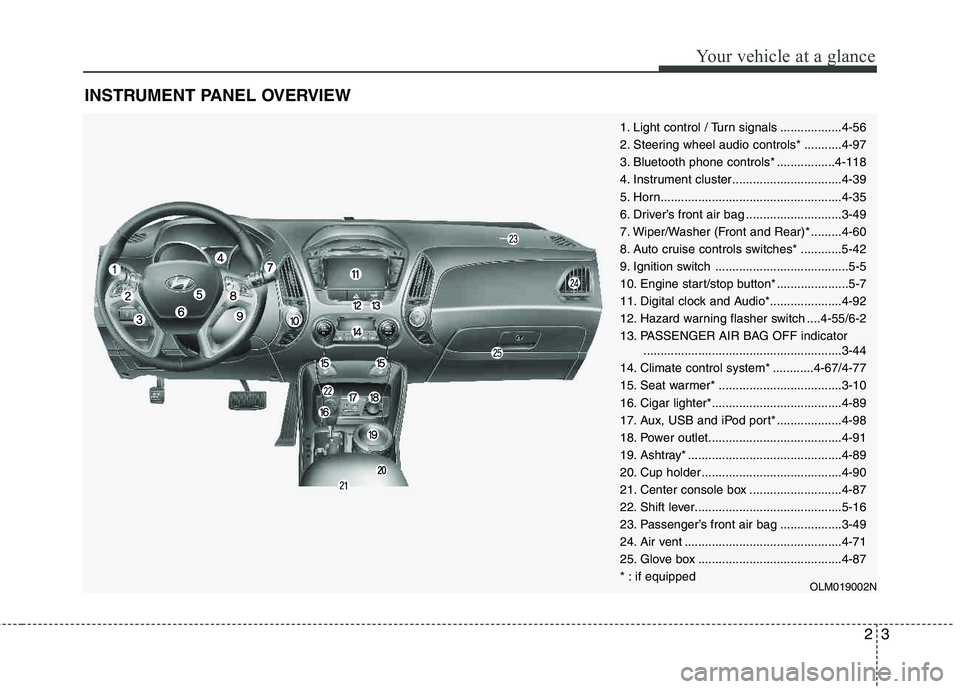
23
Your vehicle at a glance
INSTRUMENT PANEL OVERVIEW
OLM019002N
1. Light control / Turn signals ..................4-56
2. Steering wheel audio controls* ...........4-97
3. Bluetooth phone controls* .................4-118
4. Instrument cluster................................4-39
5. Horn.....................................................4-35
6. Driver’s front air bag ............................3-49
7. Wiper/Washer (Front and Rear)* .........4-60
8. Auto cruise controls switches* ............5-42
9. Ignition switch .......................................5-5
10. Engine start/stop button* .....................5-7
11. Digital clock and Audio*.....................4-92
12. Hazard warning flasher switch ....4-55/6-2
13. PASSENGER AIR BAG OFF indicator..........................................................3-44
14. Climate control system* ............4-67/4-77
15. Seat warmer* ....................................3-10
16. Cigar lighter*......................................4-89
17. Aux, USB and iPod port* ...................4-98
18. Power outlet.......................................4-91
19. Ashtray* .............................................4-89
20. Cup holder .........................................4-90
21. Center console box ...........................4-87
22. Shift lever...........................................5-16
23. Passenger’s front air bag ..................3-49
24. Air vent ..............................................4-71
25. Glove box ..........................................4-87
* : if equipped
Page 17 of 397
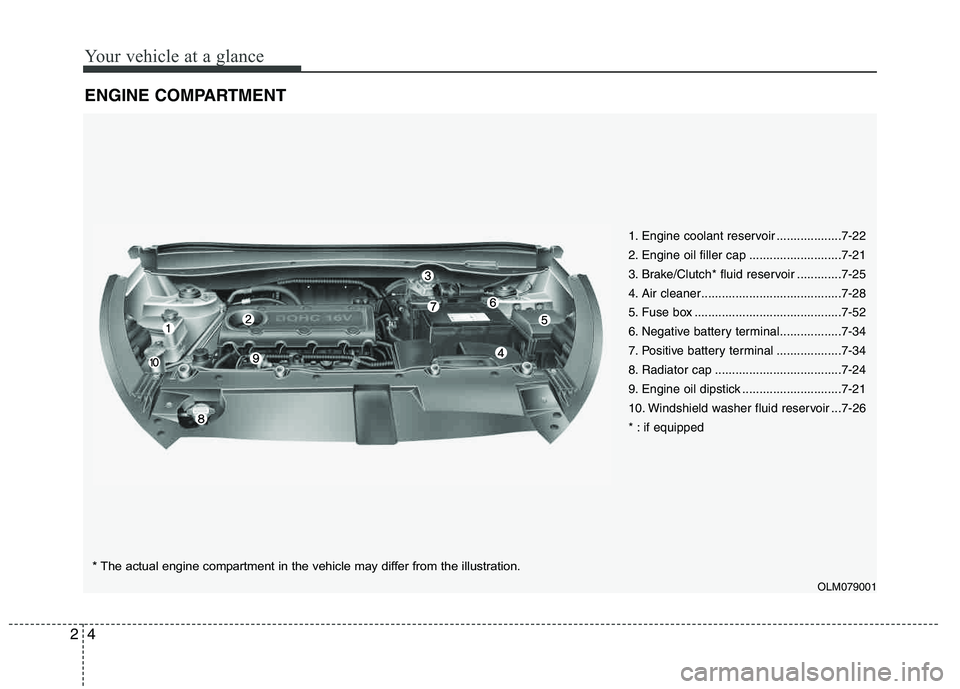
Your vehicle at a glance
4
2
ENGINE COMPARTMENT
1. Engine coolant reservoir ...................7-22
2. Engine oil filler cap ...........................7-21
3. Brake/Clutch* fluid reservoir .............7-25
4. Air cleaner.........................................7-28
5. Fuse box ...........................................7-52
6. Negative battery terminal..................7-34
7. Positive battery terminal ...................7-34
8. Radiator cap .....................................7-24
9. Engine oil dipstick .............................7-21
10. Windshield washer fluid reservoir ...7-26
* : if equipped
OLM079001
* The actual engine compartment in the vehicle may differ from the illustration.
Page 18 of 397
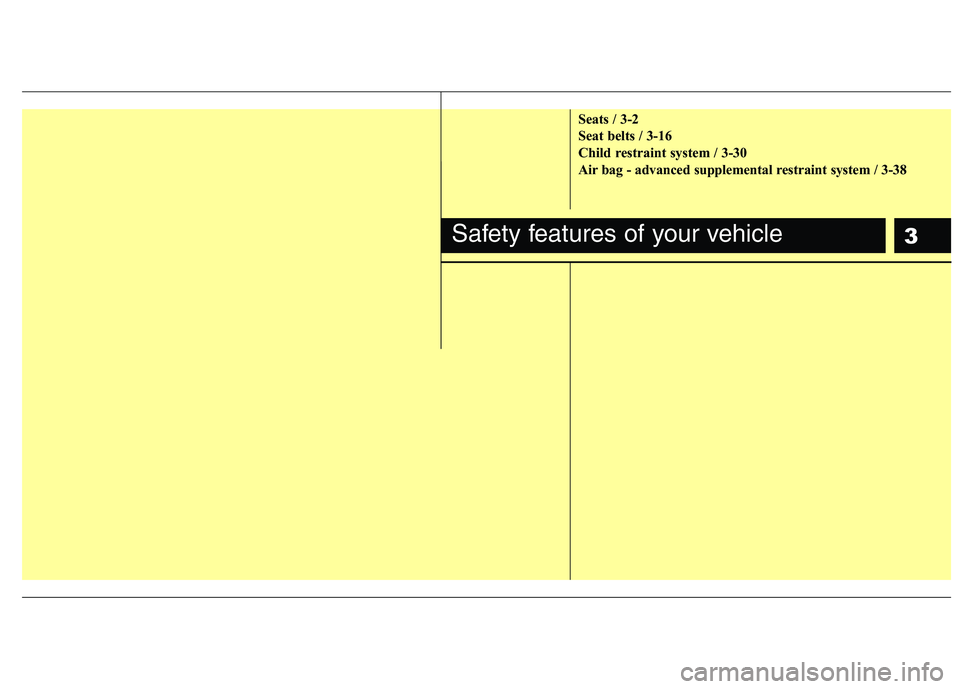
3
Seats / 3-2
Seat belts / 3-16
Child restraint system / 3-30
Air bag - advanced supplemental restraint system / 3-38
Safety features of your vehicle
Page 19 of 397

Safety features of your vehicle
2
3
Front seat
(1) Forward and backward
(2) Seatback angle
(3) Seat cushion height (Driver’s seat)*
(4) Lumbar support (Driver’s seat)*
(5) Seat warmer* (6) Headrest
Rear seat
(7) Seatback folding (8) Headrest
(9) Armrest
*: if equipped
SEATS
OLM031001L
Manual seat
Power seat
Page 20 of 397
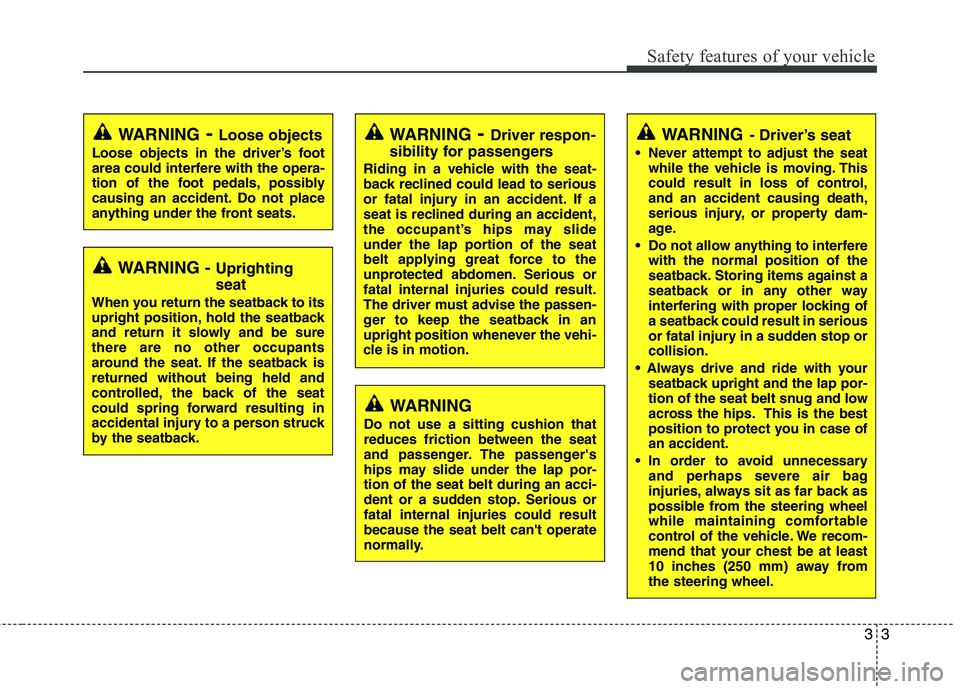
33
Safety features of your vehicle
WARNING- Driver’s seat
Never attempt to adjust the seatwhile the vehicle is moving. This
could result in loss of control,and an accident causing death,
serious injury, or property dam-
age.
Do not allow anything to interfere with the normal position of the
seatback. Storing items against a
seatback or in any other way
interfering with proper locking of
a seatback could result in serious
or fatal injury in a sudden stop orcollision.
seatback upright and the lap por-
tion of the seat belt snug and low
across the hips. This is the best
position to protect you in case of an accident.
In order to avoid unnecessary and perhaps severe air bag
injuries, always sit as far back as
possible from the steering wheel
while maintaining comfortable
control of the vehicle. We recom-
mend that your chest be at least
10 inches (250 mm) away fromthe steering wheel.
WARNING - Uprighting seat
When you return the seatback to its
upright position, hold the seatback
and return it slowly and be sure there are no other occupants
around the seat. If the seatback isreturned without being held and
controlled, the back of the seat
could spring forward resulting in
accidental injury to a person struck
by the seatback.
WARNING- Loose objects
Loose objects in the driver’s foot
area could interfere with the opera-
tion of the foot pedals, possibly
causing an accident. Do not place
anything under the front seats.
WARNING- Driver respon-
sibility for passengers
Riding in a vehicle with the seat-
back reclined could lead to serious
or fatal injury in an accident. If a
seat is reclined during an accident,
the occupant’s hips may slide
under the lap portion of the seat
belt applying great force to the
unprotected abdomen. Serious or fatal internal injuries could result.
The driver must advise the passen-
ger to keep the seatback in an
upright position whenever the vehi-
cle is in motion.
WARNING
Do not use a sitting cushion that reduces friction between the seat
and passenger. The passenger's
hips may slide under the lap por-tion of the seat belt during an acci-
dent or a sudden stop. Serious or fatal internal injuries could resultbecause the seat belt can't operate
normally.